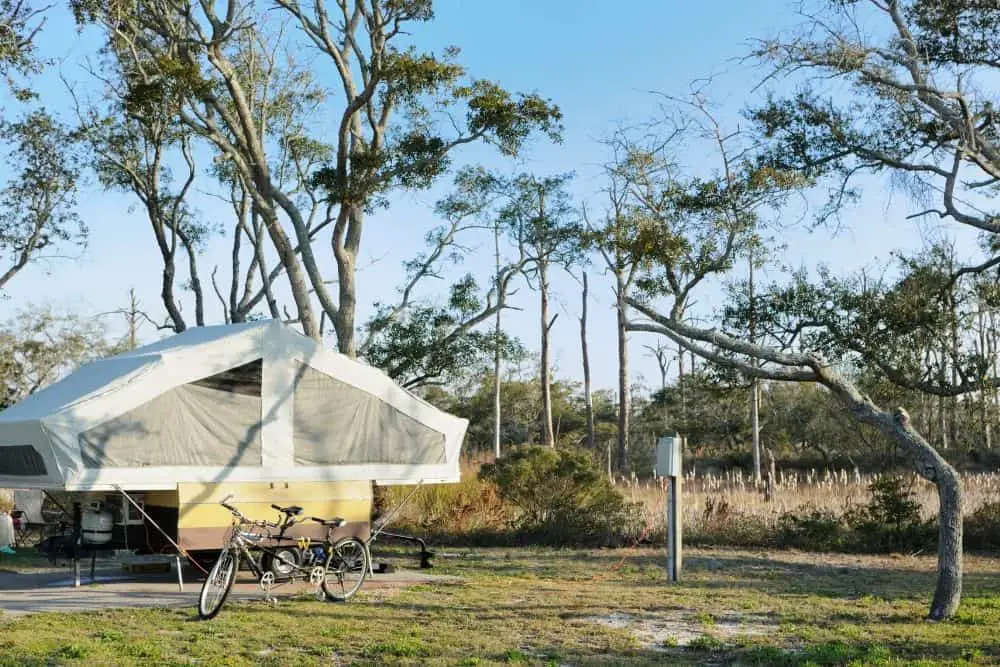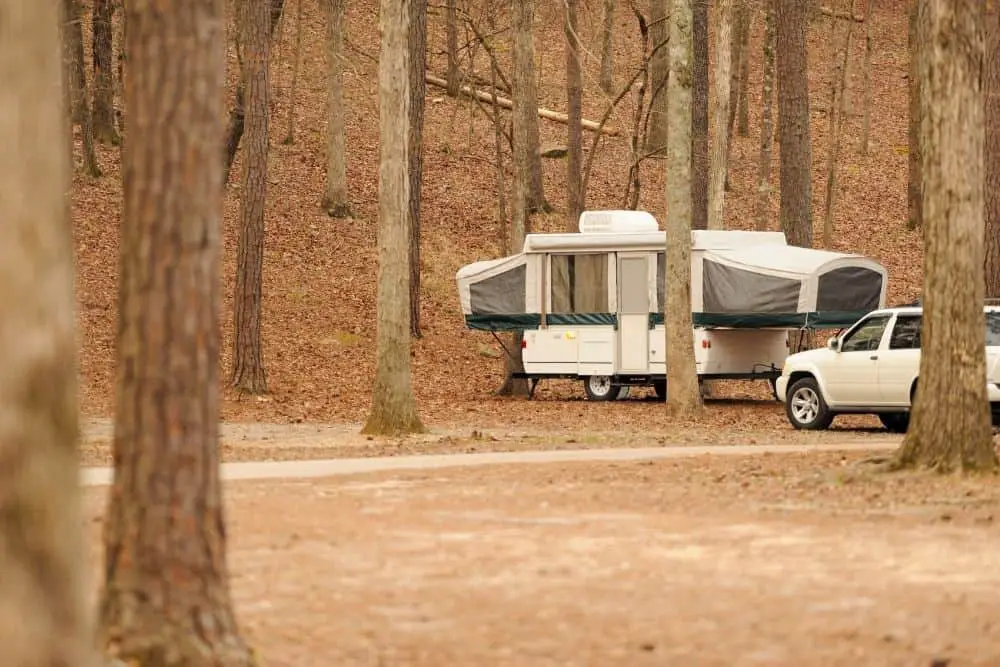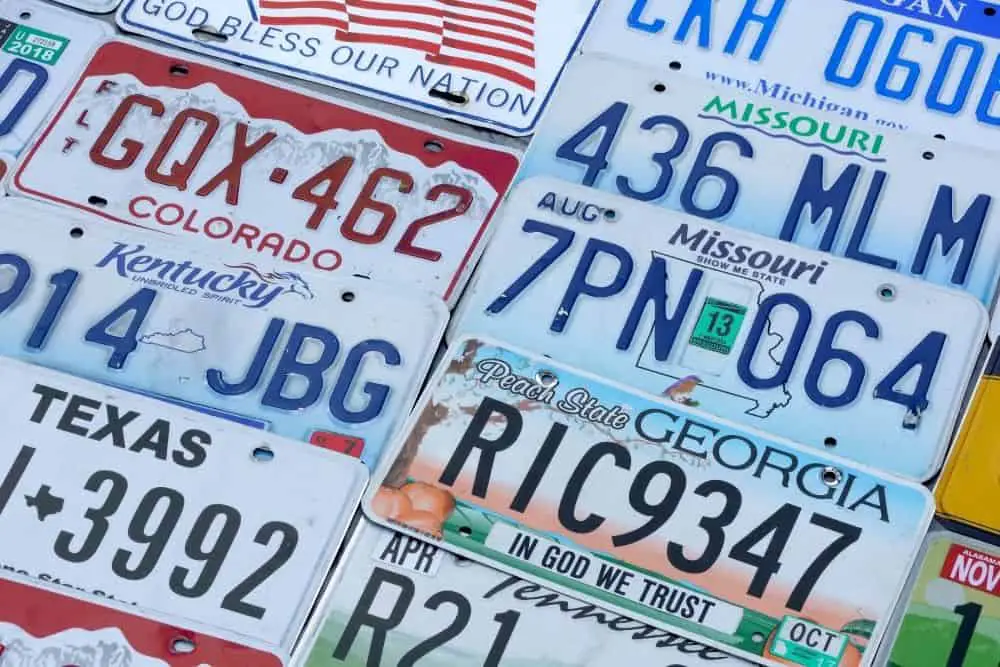If you’re thinking about using a pop-up camper to go camping, you’re probably wondering how much wind it can handle. Do pop-up campers pose any threat during severe wind storms? That’s something I’d like to know for sure.
How much wind can a pop-up camper take and is it dangerous? Even in 40MPH winds, the majority of pop-up campers will remain stable. Wind gusts rocked pop-up campers and generated a lot of noise, making many campers concerned. While camping in a pop-up camper during a big wind storm is not harmful, extreme caution is advised. However, a pop-up camper’s ability to withstand wind varies depending on a number of things.
To keep your pop up camper stable while camping in severe winds, there are a few things you can do before heading out to your campsite.
How much wind can a pop up camper take?
A pop-up camper’s ability to withstand wind varies depending on a number of things. This comprises the dimensions of the item, such as its height and width.
High-profile trailers can be easily flipped when the wind blows perpendicular to the truck, as was discovered in a 1995 study.
Because of their aerodynamic designs, low-profile vehicles like cars and trucks were shown to be less likely to flip over, according to the researchers.
They discovered the following:
| Length of trailer | Max. Wind speed |
| 16.4 feet | 101 MPH |
| 18 feet | 53 MPH |
| 29.5 feet | 65 MPH |
Average length of a pop up camper
The length of a pop-up camper is defined by the size of its box, or how long it is when closed. Some pop-up campers extend to 16 feet in length, while others are just 10-12 feet.
To get an idea of how long your pop-up camper will be when fully opened, multiply the length by two.
Average height of a pop up camper
All pop-up campers are made to be as aerodynamic as possible when being pulled behind a vehicle. How much wind your car can take also determines how much your pop-up camper can take while being hauled.
About 10-11 feet high is the normal height of a high-profile trailer. Normally, even the tallest pop-up campers don’t go much higher than 10-15 feet in height when they are fully opened.
Average weight of a pop up camper
The weight of your pop-up camper also has an effect on how much wind it can withstand. The weight of pop-up campers typically ranges from 600 pounds to 4,500.
The average weight of a pop-up camper is 2,000 pounds. When calculating the amount of wind required to topple a camper, keep in mind the vehicle’s weight and center of gravity.
During heavy wind storms, a heavier camper will be more stable. Be sure to account for the weight of your personal things, fresh water in your freshwater tank, and the people or animals who will be staying with you.
Verify the ratings and specifications of your pop-up camper to make sure you are prepared.
Is it dangerous to camp in a pop up camper during a windstorm?
In low to moderate wind storms, pop-up camping can be unsettling, but it’s not dangerous. When the wind speed exceeds 40 mph, however, it is vital to take cautious precautions to ensure your safety.
When the wind blew over 40 miles per hour, some campers saw their pop-up trailer rocking and swaying. Their pop-up camper, for the most part, remained mostly stable.
High winds shouldn’t be a problem with properly set-up lift systems, which are built to bear the wobble of extended road trips and hauled over rougher ground or even off-road.
Wind in a Pop Up Camper!
Actions you can take to keep your pop up camper stable
Summer storms and spring showers have nothing on your pop-up camper. Its weight is distributed evenly across its whole surface area, and its center of mass is low in relation to the ground. The good news is that there are a few things you can do to make your pop-up camper more sturdy and secure when exposed to strong winds.
- Plan ahead. Think about where you’ll be camping and what the weather will be like while you’re there. Plan for extreme wind conditions if you know they’re likely, and be ready for them so you aren’t caught off guard.
- Choose your camping spot wisely. If at all feasible, pick a camping location that isn’t too exposed to the wind. Avoid parking under large trees if you can help it. Especially those that have rotten or shattered limbs.
- Have a secure shelter. Whether you’re camping in a designated area, investigate if there are any shelter-in-place locations there. In most restrooms and showers, you’ll find this.
- Consider guy lines and ground anchors. Weather-dependent campers may want to invest in ground anchors and tie-down straps. Awnings in particular are infamous for being blown off or tearing off. Anchoring a tent-like structure, such as an E-Z up, uses a similar technique.
- Bring your awning in. Never leave your awning alone while you’re away from your campsite. You must bring it inside and secure it against the pop-up trailer at all times! Bring anything else that could be blown away, like camping chairs or tables.
- Carry a weather alert radio. A reliable weather alert radio is a must-have for staying on top of the latest weather conditions. Include new batteries whenever possible. This way, you’ll never be caught off guard by poor weather and be ready if something happens.
- Use quality chocks. Even if you take all other precautions, having a good set of wheel chocks is critical. Plastic chocks can easily roll away in heavy winds, so avoid using them. To prevent your wheels from going in one way or another, use high-quality rubber blocks.
- Bring in slide outs. You may wish to move your slideouts inside if the wind is particularly strong. As a result, your camper is less vulnerable to the impacts of wind. Even so, other campers didn’t bother, and they were perfectly content sleeping through the storm in their warm and cozy tents.
- Lower roof if necessary. If the storm is particularly severe, you may want to think about lowering your roof. It’s a last resort because lowering your roof needs a number of other actions if the winds are particularly strong and you’re worried about your camper blowing away. It’s also time-consuming and pointless.
- Leave your pop up camper attached to your tow vehicle. If there is a lot of wind where you are, leaving your pop-up camper attached to your tow vehicle may help stabilize it a little bit more in severe winds.
- Use stabilizer bars while towing. When being towed down the road, pop up campers sway even though they are supposed to fit neatly behind your tow car. When towing a pop-up camper, stabilizer bars can help distribute the weight more evenly.
- Decide when it’s time to leave. You’ve got your tent all set up and are having a ball. For an emergency or unexpected strong wind storm, you’ve taken all the required safeguards. However, if the storm intensifies, you may want to leave your campground altogether.
Pop Up Campers are Built to Withstand Wind
In terms of construction and design, pop-up campers are constructed to tolerate some wind. It’s safe to camp in your pop-up camper even if it’s windy outside. Although you may be alarmed by the noise and swaying action.
When the wind surges to exceed 40 mph, you should take preventive precautions to protect yourself, but don’t panic. Take the time to do your homework and relax in your pop-up camper.



